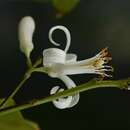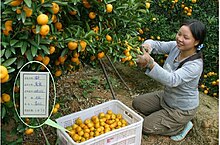en
names in breadcrumbs


None of the cultivars, formerly recognized as species, has been found in truly "natural" habitats. They are cultivated on a large scale in S China and have sometimes become naturalized. Citrus japonica and C. reticulata are parents of C. ×microcarpa. Many of the above synonyms can perhaps best be referred to cultivar groups, corresponding to the subformae of Hiroe. Commonly seen cultivar groups in China have the following characteristics, but some cultivars are intermediate.
Round Kumquat Group
Trees 2-5 m tall. Petiole 6-10 mm or rarely longer, wings narrow; leaf blade ovate-elliptic to elliptic-lanceolate, 4-8 × 1.5-3.5 cm, base broadly cuneate, apex obtuse and sometimes mucronate. Flowers 1-3 per fascicle; peduncle 6 mm or less. Petals 6-8 mm. Stamens 15-25. Ovary globose, ± as long as style, 4-6-loculed. Fruit orangish yellow to orangish red, globose, 1.5-2.5 cm in diam., 2-5-seeded; pericarp 1.5-2 mm thick, sweet. Seeds ovoid, base rounded; embryo solitary. Fl. Apr-May, fr. Nov-Feb.
Oval Kumquat Group
Trees to 3 m tall. Petiole ca. 1.2 cm, wings very narrow; leaf blade ovate-lanceolate to long elliptic, 5-11 × 2-4 cm, base broadly cuneate to nearly rounded, apex obtuse to slightly acute. Flowers 1-3 per fascicle; peduncle 3-5 mm. Petals 6-8 mm. Stamens 20-25. Ovary elliptic; style usually ca. 1.5 × as long as ovary, slender; stigma slightly clavate. Fruit orangish yellow to orangish red, ellipsoid to ovoid-ellipsoid, 2-3.5 cm in diam., oil dots usually slightly expanded, 2-5-seeded; pericarp ca. 2 mm thick, sweet; sarcocarp in 4 or 5 segments, acidic. Seeds ovoid, apex acute; embryo solitary or rarely numerous. Fl. Mar-May, fr. Oct-Dec.

The kishu mikan (Citrus kinokuni ex Tanaka) is a hybrid variety of mikan, or mandarin orange (Citrus reticulata), found in Southern China and also grown in Japan.[1] It is not closely related to the common sweet orange, but it is closely related to the mandarin orange.
The fruit is also known as Baby Mandarin, Tiny Tangerine, Mini Mandarin and Kishu Mandarin. It is sold under the brand name "Cherry orange" in Europe. It is shaped like a mandarin, between 25 and 50 mm (0.98 and 1.97 in) in diameter. The fruit's orange skin is thin and smooth.
Some varieties of kishu,[2] such as the mukaku kishu, are seedless.[3] The species is used in creating seedless hybrid citrus.[4] The largest variety is the hira kishu.[3]

The fruit is thought to have arisen in Southern China; it is believed to have been grown since the 700's.[5] Its name was recorded in the records of Jianchang during the Ming Dynasty, and its agricultural growth is widespread in Jiangxi province.[6] The variety was introduced to Japan around 1200 and remained the most popular citrus in Tokyo until the eighteen hundreds.[5]
Genetic studies have found it to be closely related to the Huanglingmiao mandarin, carrying the same pomelo (Citrus maxima) introgression, indicating that the two diverged from the same backcrossed domesticated ancestor.[7] Under the Tanaka system of citrus taxonomy, it is a separate species named Citrus kinokuni, while the Swingle system groups it with other pure and hybrid mandarins as a single species, Citrus reticulata.
Kishu mikans were introduced to America in the eighteen hundreds but were not widely known.[5] A seedless cultivar was developed for commercial production starting in 1983 at the University of California Citrus Research Center, and the fruit is now commercially available at specialty markets throughout California.[8][9] It was first grown commercially in the US in the 1990s,[5] and started to be widely grown in the United States around 2010.[2]
The fruit was made available in Europe in 2006.[5]
The fruit is high in vitamin C, like other mandarins. The fruit is enveloped in a thin skin (0.11 cm or 0.043 in) and has 7–19 sections. One variety is seedless; others have seeds.[2]
Kishu mikan plants are small evergreen and perennial trees. They grow rapidly to a size of about 4 feet (1.2 meters) diameter and 10 feet (3.0 m) height. They are commonly planted in household gardens in Japan and additionally grown in greenhouses, balconies, and in commercial orchards.[5]
The trees require five hours of sun each day and temperatures ranging from 55–75 °F (13–24 °C). They thrive on high humidity, but require well-drained soil. Manual transfer of pollen between blossoms may improve yield.[5]
The fruit grows to 1–2 in (25–51 mm) size and is harvested in mid-winter: in the Northern Hemisphere, this is November to February, depending on the local climate. When the fruit is left on the tree for too long, it can lose its flavor. Trees may fruit in their first year and typically yield 88 lb (40 kg) of fruit annually.[5]
The fruit needs to be handled with care to avoid damage to the outer skin.
 A sweet orange (largest), another variety of mikan, or mandarin orange (middling), and a kishu mikan (smallest)
A sweet orange (largest), another variety of mikan, or mandarin orange (middling), and a kishu mikan (smallest) The kishu mikan (Citrus kinokuni ex Tanaka) is a hybrid variety of mikan, or mandarin orange (Citrus reticulata), found in Southern China and also grown in Japan. It is not closely related to the common sweet orange, but it is closely related to the mandarin orange.
The fruit is also known as Baby Mandarin, Tiny Tangerine, Mini Mandarin and Kishu Mandarin. It is sold under the brand name "Cherry orange" in Europe. It is shaped like a mandarin, between 25 and 50 mm (0.98 and 1.97 in) in diameter. The fruit's orange skin is thin and smooth.
Some varieties of kishu, such as the mukaku kishu, are seedless. The species is used in creating seedless hybrid citrus. The largest variety is the hira kishu.